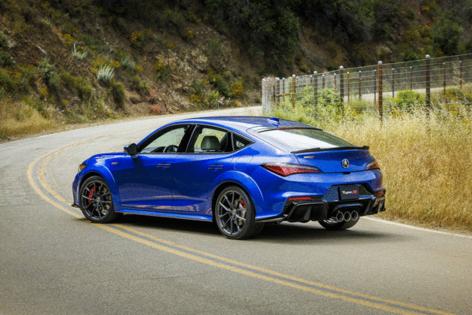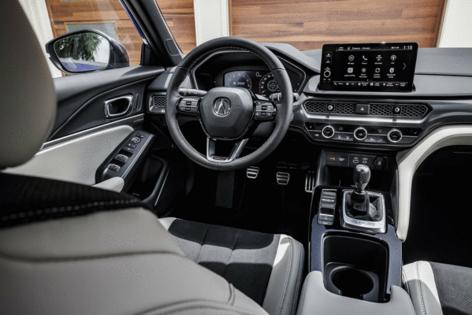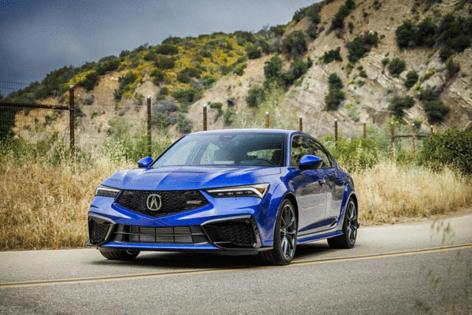Auto review: Integra Type S: It's the right type for sport drivers
Published in Automotive News
If you’re the type of driver who cares less about getting from A to B, and more about how much fun it might be getting to B, Acura knows your type. If you like sleek styling, raw power and rally handling, but want enough comfort for daily driving, too, Acura knows your type.
Acura calls it the Type S. The 2024 Integra Type S, a premium sport compact, is the most powerful Integra ever built at 320 horsepower. Its performance was developed by motorsports engineers, and it barks and pops through an eye-grabbing, massive trio of exhaust outlets. This one is a little beast.
For around town or the long drive to that wacky brother-in-law, just flip into comfort mode and it becomes a gentler animal with a softer, more compliant and quieter ride.
The Type S (for sport) is based on the Honda Civic Type R (racing) but looks classier, has more amenities and no big, bawdy wing at the rear. Rather, a modest carbon-fiber spoiler rides the lift back (for an extra $950). But refined racy doesn’t come cheap — the S costs about $7,000 more than the R.
The Type S already has won kudos from Road & Track magazine as Performance Car of the Year under $100,000, and Car & Driver ranked it tops in its segment.
To confirm this is a driver’s machine, the Type S is available only with a six-speed manual tranny. No automatics here. But the shifts are fluid and you’ll want the extra control on the twisty roads and corners. (Good news for warm regions: The metal shift knob that melted fingers has been wrapped in leather this year).
The aerodynamic Integra is a looker, with inverted pentagon grille, multi-jeweled LED headlights, and gloss-black air vents on the hood and at the front corners. Sides are nicely contoured, complemented by flared wheel wells and carbon-fiber mirror caps. The name Integra is embossed into the front and rear bumpers.
A reworked 2.0-liter turbo four delivers the 320 hp and 310 pound-feet of torque to the front wheels only — no all-wheel-drive is available. With little torque pull, the Integra runs to 60 mph in a decent 5.5 seconds and the quarter-mile in 13.9. That’s not as quick as rivals like BMW M235i, Audi S3, and Mercedes CLA 35, but those guys don’t offer a manual shifter either.
Besides, the Acura is not about brutish speed but gazelle-like agility made possible by ultra-responsive steering, race-engineered front suspension, and 265-width Michelin Pilot high-performance tires for grip. It’s about clipping the apex.
In Sport-Plus, it does all that, with a nod to Acura’s capable front limited-slip differential. There is some low-gear wheel spinout — thanks to the FWD — but it’s eager and fun on corners. A sunroof was excluded to keep the body more rigid, better for handling.
For most, Sport mode (there is a Sport Plus, too) will be the happy place for brisk drives. It offers tight steering feedback and hugs the asphalt while staying as composed on twistys at 45 as it is at 25. An Individual mode lets you mix and match, with separate settings for throttle, steering and suspension firmness.
In Comfort mode, adaptive dampers soften the ride and calm the engine noise. All Integras are quieter this year with increased sound-deadening materials in the floor and firewall to reduce wind and road noise.
Braking is sure and firm, too, employing red Brembo front calipers and ventilated rotors.
The Type S is on par with its competitors on fuel economy, getting 28 mpg highway and 21 mpg city, for a combined 24 mpg, according to the EPA.
Inside, two-tone seats look sharp, trimmed in faux leather with microfiber inserts. Front seats are well bolstered but not race-hugging like the Civic R, and cushions are more comfortable. The driver gets 12-way power adjustment while the front passenger is left to adjust manually. There are no memory settings for the driver seat, so just tell friends you don’t want to mess with the settings.
The rear seat offers generous legroom, but not so much on the headroom, at least for six-footers. But the seats fold down in a 60/40 split to create a capacious cargo area of 24.3 cubic feet, which bests the competition. It also is easily accessed through a gaping lift back.
Cubbies and slots offer ample room for small stuff, especially in the center console. There’s space inside it, in front, behind it, and there’s even an area underneath the armrest.
A 9-inch infotainment touchscreen is smallish compared to some foes and does not include navigation as standard. But the system is responsive, easy to use, and compatible with Apple CarPlay and Android Auto. Alexa can help, too. Wireless phone charging is standard.
Acura’s 10.2-inch Precision Cockpit data center looks cool with its colors, contrast and animated displays. A standard head-up display has key data like speed limits and driver-assist alerts.
Tunes are enhanced through a 16-speaker ELS Studio 3D premium audio system, also standard.
AcuraWatch, the carmaker’s advanced driver-assist system, is standard on every sedan and SUV. It includes adaptive cruise control, automatic emergency braking, collision mitigation which alerts the potential for a crash, pedestrian detection, plus lane-keep assist and road departure prevention.
The Integra may be Acura’s smallest and most affordable model, but it’s no longer just an entry-level sport compact. The all-new Type S ignites some real passion and punch to the model.
2024 Acura Integra Type S
MSRP:$50,800
As tested$53,785 (Includes carbon fiber spoiler, $950; premium paint and floor mats, $1,190; destination/handling)
What's all the excitement about? New model Type S brings sleeker look, turbo power and much-needed brisker handling to the Integra
Powertrain: 2.0-liter VTEC four-cylinder engine produces 320 hp and 310 pound-feet of torque, mated to a mandatory 6-speed manual transmission
How's the performance? Not the fastest in segment, but sprints to 60 mph in 5.5 seconds, quarter-mile in 13.9; precision steering, firm braking with Brembo front calipers and ventilated rotors
Fuel economy: About average for segment at EPA-estimated 24 mpg combined: 28 highway, 21 city
©2024 Tribune Content Agency, LLC













Comments